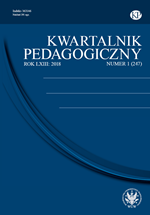Postrzeganie środowiska psychospołecznego szkoły i funkcjonowanie w niej uczniów zdrowych i z chorobami przewlekłymi
School setting perception and functioning among lower secondary school students with and without chronic conditions
Author(s): Agnieszka Małkowska-Szkutnik, Barbara Woynarowska, Joanna MazurSubject(s): Social Sciences, Education
Published by: Wydawnictwa Uniwersytetu Warszawskiego
Keywords: school setting perception; school setting functioning; healthy students; students with chronic conditions; lower secondary schools
Summary/Abstract: The article presents the results of a survey on the perception of the psychosocial school environmentand school functioning of lower secondary school students with and without chronicconditions. Students of grades 1–3 (N = 4,058) from randomly selected 234 public lowersecondary schools from all voivodships participated in the survey. In this group 3,232 (80%)students were healthy and 798 (20%) had different chronic conditions. The anonymous “Healthand school” questionnaire was used as the instrument for data collections with questions fromHBSC study (Health Behaviour in School-aged Children) and from CHIP–AE Questionnaire (ChildHealth and Illness Profile: Adolescent Edition). Based on Urie Bronfenbrenner’s ecological model,dimensions of psychosocial school environment were analysed on the individual level (microsystem)and the social relations level (mesosystem). It was found that healthy students, incomparison with those with chronic conditions, perceived school environment and theirfunctioning at school better. They have: a larger sense of school belonging, higher level of schoolcompetencies and achievements, larger sense that their grades are adequate to the results,a higher social position in the class and a higher level of support from peers, teachers andparents. Students with chronic conditions have higher level of workload, stress and problemsassociated with the school, and they also spend more time on homework. These students(about 20% of the population of school age) have special educational needs which depend onthe specificity and the course of the disease. Identification of difficult areas in the functioningof chronically ill students in the school and knowledge of their perception of their school’spsychosocial environment will allow teachers to provide them with appropriate support.
Journal: Kwartalnik Pedagogiczny
- Issue Year: 247/2018
- Issue No: 1
- Page Range: 179-197
- Page Count: 19
- Language: Polish
- Content File-PDF

